Test and Numerical Simulation of the Axial Compressive Capacity of Concrete Columns Reinforced by Duplex Stainless Steel Bars
Abstract
:1. Introduction
2. Experimental Program
2.1. Material Properties
2.2. Component Design and Manufacture
2.3. Measurement Point Arrangement and Loading Method
3. Test Results and Analysis
3.1. Analysis of Experimental Phenomena and Failure Modes
3.2. Force Analysis
3.2.1. Load–Displacement Curve
3.2.2. Load–Strain Curves of Steel Bars
3.2.3. Concrete Strain Analysis
3.2.4. Calculation of the Axial Compressive Load-Bearing Capacity of DSSRC Columns
4. ABAQUS Finite Element Analysis of DSSRC Columns
4.1. Material Modeling
4.1.1. Constitutive Model of the Stainless Steel Bar
4.1.2. Constitutive Model of the Concrete
- (1)
- Under uniaxial tensile loading:
- (2)
- Stress condition:
4.2. Establishment of the Computational Model
4.3. Analysis of Numerical Calculation Results
5. Conclusions
- (1)
- S2205 duplex stainless steel reinforcement has good bonding properties with concrete. Compared to the concrete columns reinforced with normal steel bars, the increase in cracking load was 20.7%, 12.7%, and 49.3% when the main reinforcement was 10 mm, 12 mm, and 14 mm, respectively.
- (2)
- The concrete columns reinforced with duplex stainless steel bars have significantly higher ultimate load-bearing capacity than those reinforced with ordinary steel bars. When the main reinforcement was 10 mm, 12 mm, and 14 mm, the increase in ultimate loading was 30.7%, 17.5%, and 27.9%, respectively.
- (3)
- The load-strain characteristic curves of concrete columns reinforced with S2205 steel bars are similar to those of concrete columns reinforced with ordinary steel bars. It was observed that both the longitudinal bar strain and concrete compressive strain showed a gradual increase with increasing load.
- (4)
- The formula for calculating the axial compressive capacity of ordinary steel-reinforced concrete columns can be used to calculate the axial compressive capacity of SSRC columns. In contrast, the load-bearing capacity of the short duplex SSRC columns obtained from numerical analysis was larger, with increases ranging from 9% to 21%.
- (5)
- Finite element simulation analysis for axial compression tests of short columns with duplex stainless steel reinforcement was performed using ABAQUS software. The results indicate that the mathematical model developed in the paper is applicable.
Author Contributions
Funding
Data Availability Statement
Conflicts of Interest
References
- Gautam, L.; Kalla, P.; Jain, J.K.; Choudhary, R.; Jain, A. Robustness of self-compacting concrete incorporating bone china ceramic waste powder along with granite cutting waste for sustainable development. J. Clean. Prod. 2022, 367, 132969. [Google Scholar] [CrossRef]
- Wu, K.-X.; Jin, D.-J.; Jin, W.-L.; Fan, X.-H.; Huang, Y.-L.; He, X.-Y. Life-cycle multi-attribute decision making of RC structures considering sustainability. J. Zhejiang Univ. (Eng. Ed.) 2023, 57, 1562–1572. [Google Scholar]
- Gautam, L.; Bansal, S.; Sharma, K.V.; Kalla, P. Bone-China ceramic powder and granite industrial by-product waste inself-compacting concrete: A durability assessment with statistical validation. Structures 2023, 54, 837–856. [Google Scholar] [CrossRef]
- Jiang, H.; Huang, C.; Mei, G.; Gao, X.; Tian, Y.; Sun, X. Experimental and numerical investigations on direct shear performance of UHPC dry joints. Eng. Struct. 2023, 283, 115872. [Google Scholar] [CrossRef]
- Feng, J.; Li, P.; Wu, J.; Jiang, H.; Tian, Y.; Sun, X. Shear behavior of externally prestressed UHPC beams without stirrups. Case Stud. Constr. Mater. 2023, 18, e01766. [Google Scholar] [CrossRef]
- Lollini, F.; Carsana, M.; Gastaldi, M.; Redaelli, E. Corrosion behaviour of stainless steel reinforcement in concrete. Corros. Rev. 2019, 37, 3–19. [Google Scholar] [CrossRef]
- Wu, X.; Ye, D.; Li, H.; Yu, H. Corrosion characteristics of S23043 duplex stainless steel bars. Constr. Build. Mater. 2018, 178, 135–143. [Google Scholar] [CrossRef]
- Fahim, A.; Dean, A.E.; Thomas, M.D.A.; Moffatt, E.G. Corrosion resistance of chromium-steel and stainless steel reinforcement in concrete. Mater. Corros. 2019, 70, 328–344. [Google Scholar] [CrossRef]
- Zhu, M.; Zhang, Q.; Yuan, Y.; Guo, S.; Huang, Y. Study on the correlation between passive film and AC corrosion behavior of 2507 super duplex stainless steel in simulated marine environment. J. Electroanal. Chem. 2020, 864, 114072. [Google Scholar] [CrossRef]
- Ogunsanya, I.G.; Hansson, C.M. Influence of chloride and sulphate anions on the electronic and electrochemical properties of passive films formed on steel reinforcing bars. Materialia 2019, 8, 100491. [Google Scholar] [CrossRef]
- James, A.; Bazarchi, E.; Chiniforush, A.A.; Aghdam, P.P.; Hosseini, M.R.; Akbarnezhad, A.; Martek, I.; Ghodoosi, F. Rebar corrosion detection, protection, and rehabilitation of reinforced concrete structures in coastal environments: A review. Constr. Build. Mater. 2019, 224, 1026–1039. [Google Scholar] [CrossRef]
- Corradi, M.; Di Schino, A.; Borri, A.; Rufini, R. A review of the use of stainless steel for masonry repair and reinforcement. Constr. Build. Mater. 2018, 181, 335–346. [Google Scholar] [CrossRef]
- Duarte, R.G.; Castela, A.S.; Neves, R.; Freire, L.; Montemor, M.F. Corrosion behavior of stainless steel rebars embedded in concrete: An electrochemical impedance spectroscopy study. Electrochim. Acta 2014, 124, 218–224. [Google Scholar] [CrossRef]
- Yin, F.; Yang, L.; Wang, M.; Zong, L.; Chang, X. Study on ultra-low cycle fatigue behavior of austenitic stainless steel. Thin-Walled Struct. 2019, 143, 106205. [Google Scholar] [CrossRef]
- Wu, X.; Li, L.; Li, H.; Li, B.; Ling, Z. Effect of strain level on corrosion of stainless steel bar. Constr. Build. Mater. 2018, 163, 189–199. [Google Scholar] [CrossRef]
- Gardner, L.; Bu, Y.; Francis, P.; Baddoo, N.; Cashell, K.; McCann, F. Elevated temperature material properties of stainless steel reinforcing bar. Constr. Build. Mater. 2016, 114, 977–997. [Google Scholar] [CrossRef]
- Medina, E.; Medina, J.M.; Cobo, A.; Bastidas, D.M. Evaluation of mechanical and structural behavior of austenitic and duplex stainless steel reinforcements. Constr. Build. Mater. 2015, 78, 1–7. [Google Scholar] [CrossRef]
- Li, C.C.; Mu, M.H.; Nie, C.X.; Li, Q.F.; Wang, H.M. Mechanical and Technological Properties of Stainless Steel Bars. Highw. Transp. Sci. Technol. 2016, 33, 1–5. [Google Scholar]
- Ji, D.J.; Qie, J.M.; Dong, F. Study on Mechanical Properties of 304 Stainless Steel bar. Foundry Technol. 2015, 36, 1682–1684. [Google Scholar]
- Huang, C. Application analysis of Stainless steel reinforcement in subway concrete structure. Munic. Technol. 2021, 39, 106–109. [Google Scholar]
- Mistry, M.; Koffler, C.; Wong, S. LCA and LCC of the world’s longest pier: A case study on nickel-containing stainless steel rebar. Int. J. Life Cycle Assess. 2016, 21, 1637–1644. [Google Scholar] [CrossRef]
- Presuel-Moreno, F.; Scully, J.R.; Sharp, S.R. Literature review of commercially available alloys that have potential as low-cost, corrosion-resistant concrete reinforcement. Corrosion 2010, 66, 0860018. [Google Scholar] [CrossRef]
- Nürnberger, U.; Wu, Y. Stainless steel in concrete structures and in the fastening technique. Mater. Corros. 2008, 59, 144–158. [Google Scholar] [CrossRef]
- Younis, A.; Ebead, U.; Judd, S. Life cycle cost analysis of structural concrete using seawater, recycled concrete aggregate, and GFRP reinforcement. Constr. Build. Mater. 2018, 175, 152–160. [Google Scholar] [CrossRef]
- Val, D.V.; Stewart, M.G. Life-cycle cost analysis of reinforced concrete structures in marine environments. Struct. Saf. 2003, 25, 343–362. [Google Scholar] [CrossRef]
- Zhang, G.X.; Wu, M.M. Application and development of stainless steel reinforced concrete. J. Foshan Univ. Sci. Technol. (Nat. Sci. Ed.) 2006, 2, 10–13. [Google Scholar]
- Yuan, H.X.; Wang, Y.Q.; Shi, Y.J. Preliminary study and application prospect of stainless steel reinforced concrete. Build. Sci. 2011, 27, 101–105. [Google Scholar]
- Zhang, X.Z.; Piao, L.; Fan, X.Y.; Ye, X.J.; Li, C.C. Application of Stainless steel bars in Durability Design of cross-sea Bridges. Highw. Transp. Sci. Technol. 2017, 34, 28–32. [Google Scholar]
- Li, Q.F.; Wang, J.W. Research progress and application of stainless steel bars. Henan Sci. Technol. 2017, 19, 107–109. [Google Scholar]
- Zheng, X.H.; Li, C.C.; Ouyang, P.; Xu, D.; Li, W. Engineering Application of Stainless steel Bar. Highw. Transp. Sci. Technol. (Appl. Technol. Ed.) 2017, 13, 42–43. [Google Scholar]
- Jing, Q.; Fang, X.; Ni, J.X.; Tang, Y.B. Application of 2304 stainless steel reinforcement in Hong Kong-Zhuhai-Macao Bridge: Research on corrosion resistance of steel reinforcement. Highw. Transp. Sci. Technol. 2017, 34, 51–56. [Google Scholar]
- Li, C.C.; He, W.N.; Lu, J.; Geng, H.T. Bonding properties of Stainless Steel bars and Concrete. Highw. Transp. Sci. Technol. 2016, 33, 15–20. [Google Scholar]
- Xu, C.Y.; Yuan, Y.S.; Lu, B.; Guo, Y.H. Anchorage design and Reliability Analysis of Duplex Stainless steel bar and Concrete. J. Shenyang Jianzhu Univ. (Nat. Sci. Ed.) 2019, 35, 445–452. [Google Scholar]
- Xu, C.Y.; Lu, B.; Yuan, Y.S. Test and Finite element simulation on bonding properties of duplex stainless steel bars and concrete. Concrete 2018, 5, 51–55. [Google Scholar]
- Zhang, L.; Qian, P.; Zhang, J.J.; Yang, J.J.; Shi, J.N.; Song, X.F. Research on flexion Performance of 304 stainless steel Reinforced concrete beams. Shanxi Archit. Archit. 2019, 45, 36–37. [Google Scholar]
- Zhang, Y.L. Experimental Study on Mechanical Performance of Stainless Steel Reinforced Concrete Columns; Zhengzhou University: Zhengzhou, China, 2019. [Google Scholar]
- Xiang, Q.H. Experimental Study on the Influence of Reinforcement Ratio on the Mechanical Performance of Stainless Steel Reinforced Concrete Columns; Zhengzhou University: Zhengzhou, China, 2020. [Google Scholar]
- Guo, W. Experimental Study on the Influence of Concrete Strength on the Mechanical Performance of Stainless Steel Reinforced Concrete Columns; Zhengzhou University: Zhengzhou, China, 2021. [Google Scholar]
- Castro, H.; Rodriguez, C.; Belzunce, F.; Canteli, A. Mechanical properties and corrosion behaviour of stainless steel reinforcing bars. J. Mater. Process. Technol. 2003, 143–144, 134–137. [Google Scholar] [CrossRef]
- Mudhaffar, M.A.; Saleh, N.; Aassy, A. Influence of hot clad rolling process parameters on life cycle of reinforced bar of stainless steel carbon steel bars. Procedia Manuf. 2017, 8, 353–360. [Google Scholar] [CrossRef]
- Corrêa, E.C.S.; Aguilar, M.; Cetlin, P. The influence of cyclic straining on the work hardening behavior of AISI 304 stainless steel bars in multiple-pass drawing. Mater. Chem. Phys. 2007, 106, 95–101. [Google Scholar] [CrossRef]
- Cadoni, E.; Fenu, L.; Forni, D. Strain rate behaviour in tension of austenitic stainless steel used for reinforcing bars. Constr. Build. Mater. 2012, 35, 399–407. [Google Scholar] [CrossRef]
- GB/T50081-2019; Standard of Test Method for Physical and Mechanical Properties of Concrete. National Standard of the People’s Republic of China: Beijing, China, 2019.
- GB/T28900-2012; Test Method for Steel Used in Reinforced Concrete. National Standard of the People’s Republic of China: Beijing, China, 2012.
- GB/T50152-2012; Standard for Test Methods of Concrete Structures. National Standard of the People’s Republic of China: Beijing, China, 2012.
- Nie, J.G.; Wang, Y.H. Comparative study of concrete constitutive Model used to simulate structural static behavior in ABAQUS. Eng. Mech. 2013, 30, 59–67. [Google Scholar]
- Li, Q.F.; Kuang, Y.H.; Guo, W. CDP model parameter calculation and value method verification. J. Zhengzhou Univ. (Eng. Ed.) 2020, 42, 43–48. [Google Scholar]
- Rasmussen, K.J. Full-range stress–strain curves for stainless steel alloys. J. Constr. Steel Res. 2003, 59, 47–61. [Google Scholar] [CrossRef]
- Abdella, K. An explicit stress formulation for stainless steel applicable in tension and compression. J. Constr. Steel Res. 2007, 63, 326–331. [Google Scholar] [CrossRef]
- Scott, B.D.; Park, R.; Priestley, M. Stress-strain Behavior of Concrete Confined by Overlapping Hoops at Low and High Strain Rates. J. Am. Concr. Inst. 1982, 79, 13–27. [Google Scholar]
- EN 1992-1 Euro Code 2; Design of Concrete Structures: Part 1-1: General Rules and Rules for Buildings. British Standards Institution: London, UK, 2004.
- GB 50010-2010; Code for Design of Concrete Structures. National Standard of the People’s Republic of China: Beijing, China, 2010.
- Fang, Z.H.; Zhou, H.J.; Lai, S.Y.; Xie, Q. Selection of Stress-strain Relationship of ABAQUS concrete. Build. Struct. 2013, 43, 559–561. [Google Scholar]


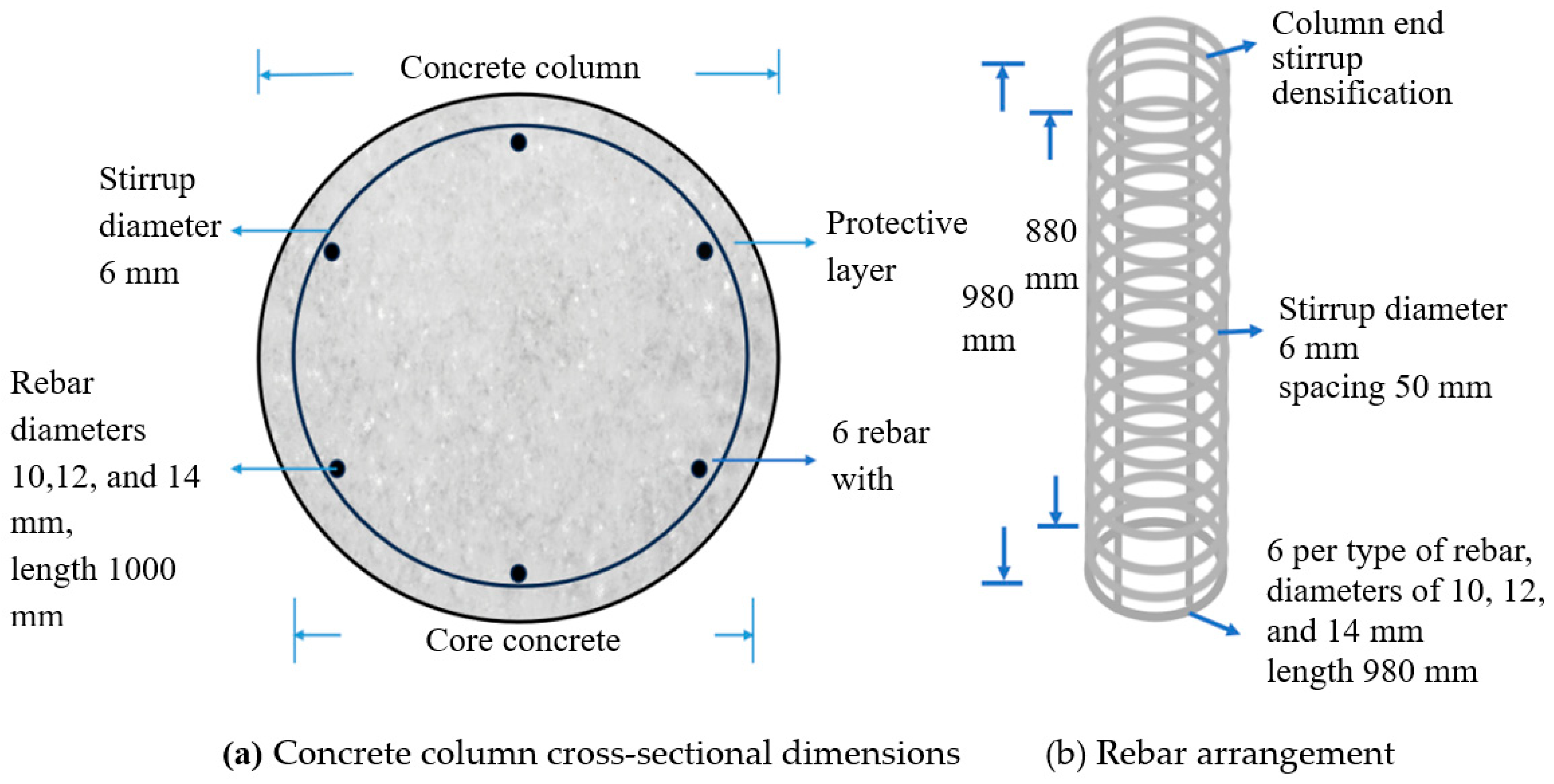
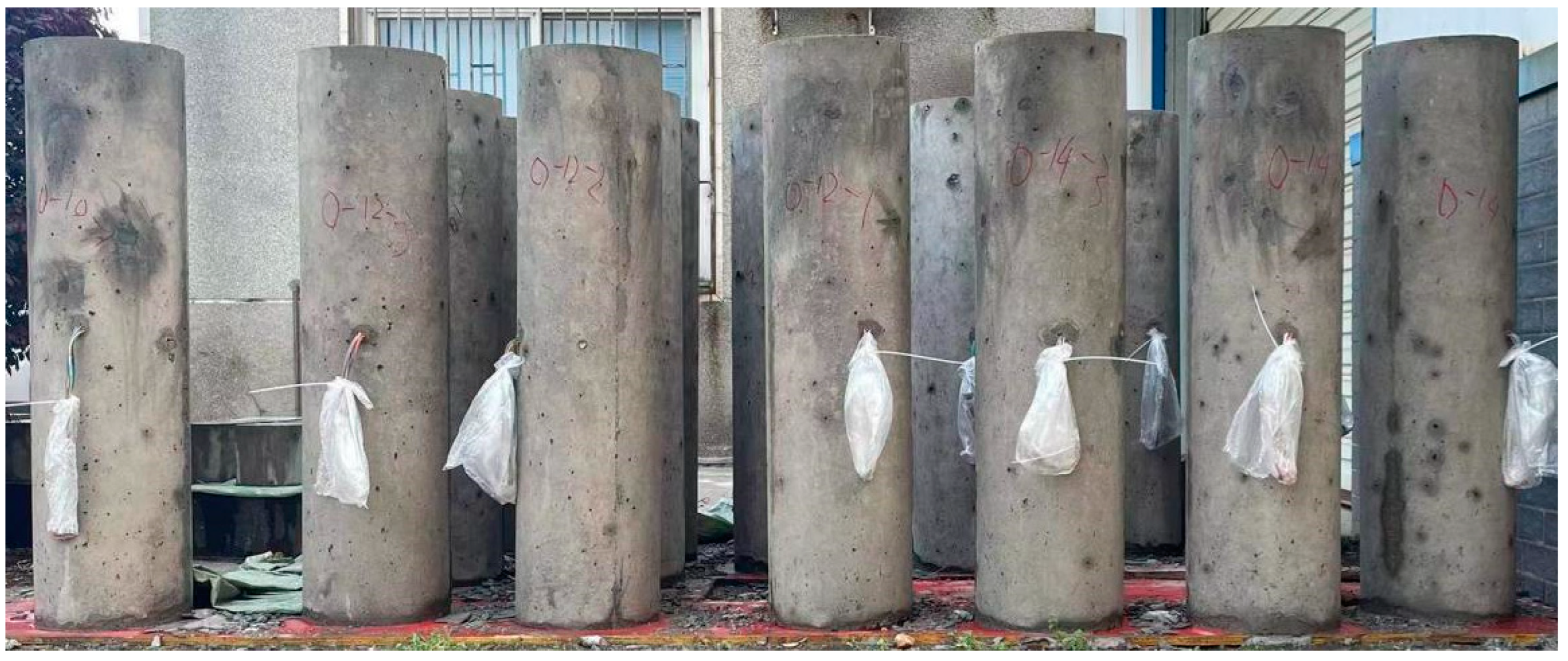
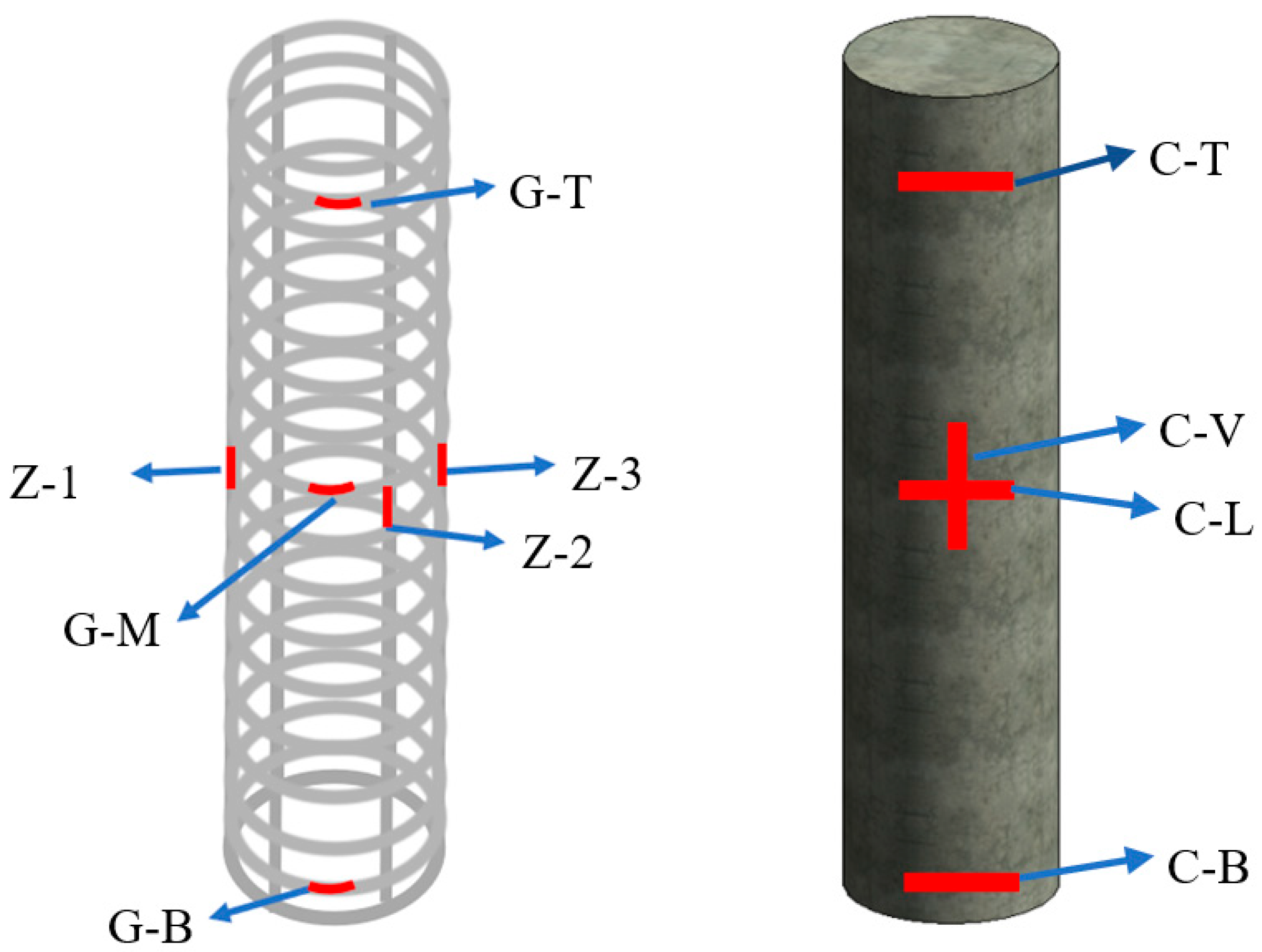
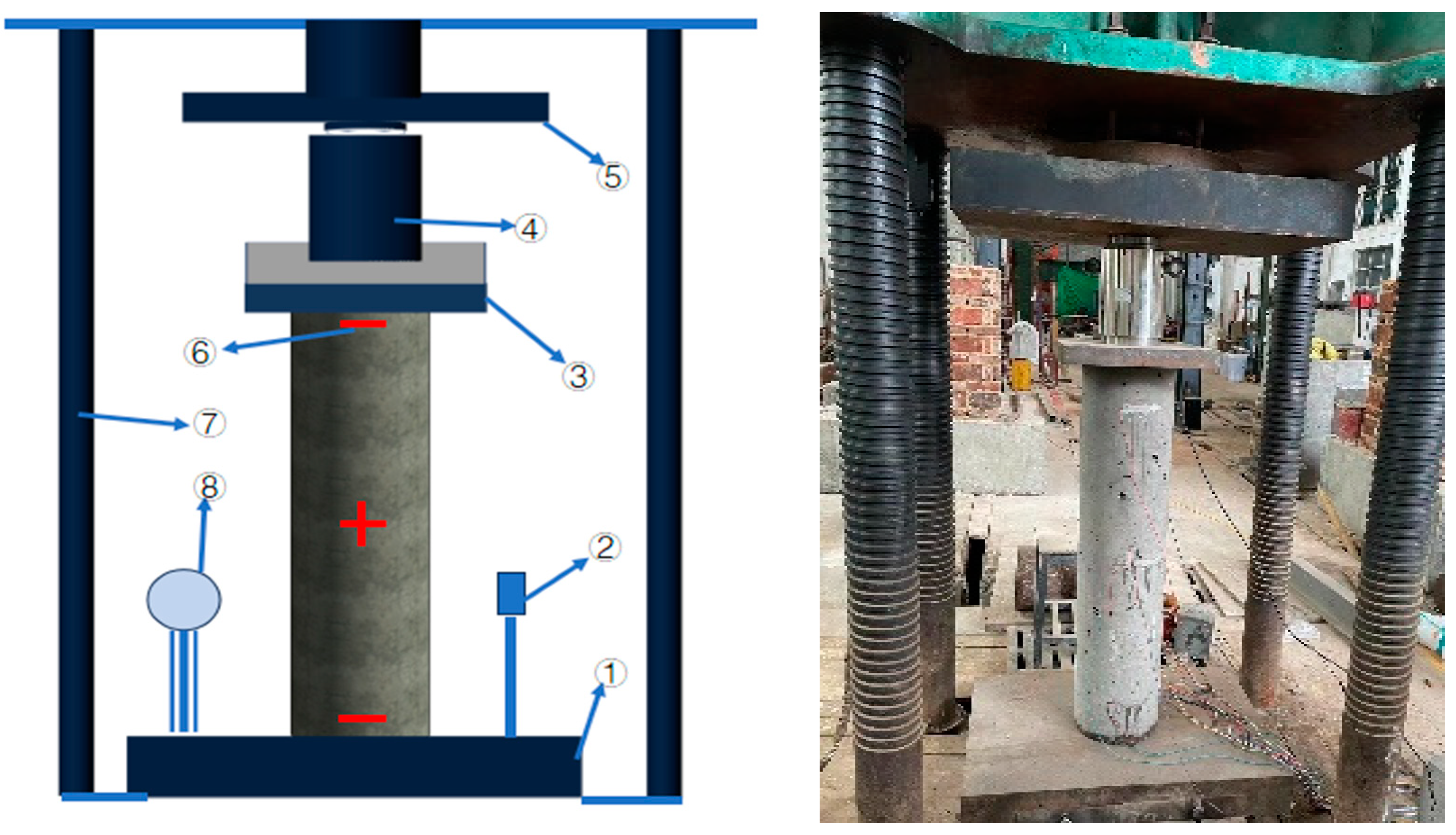
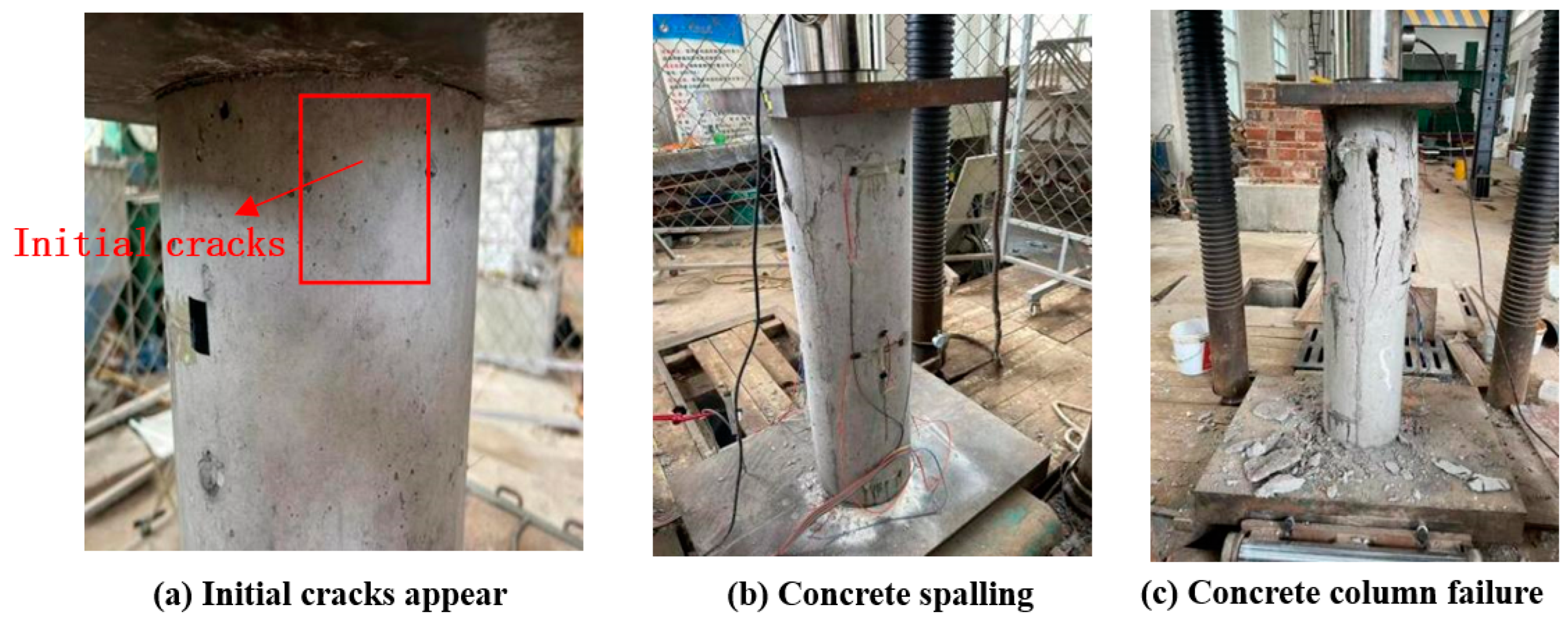

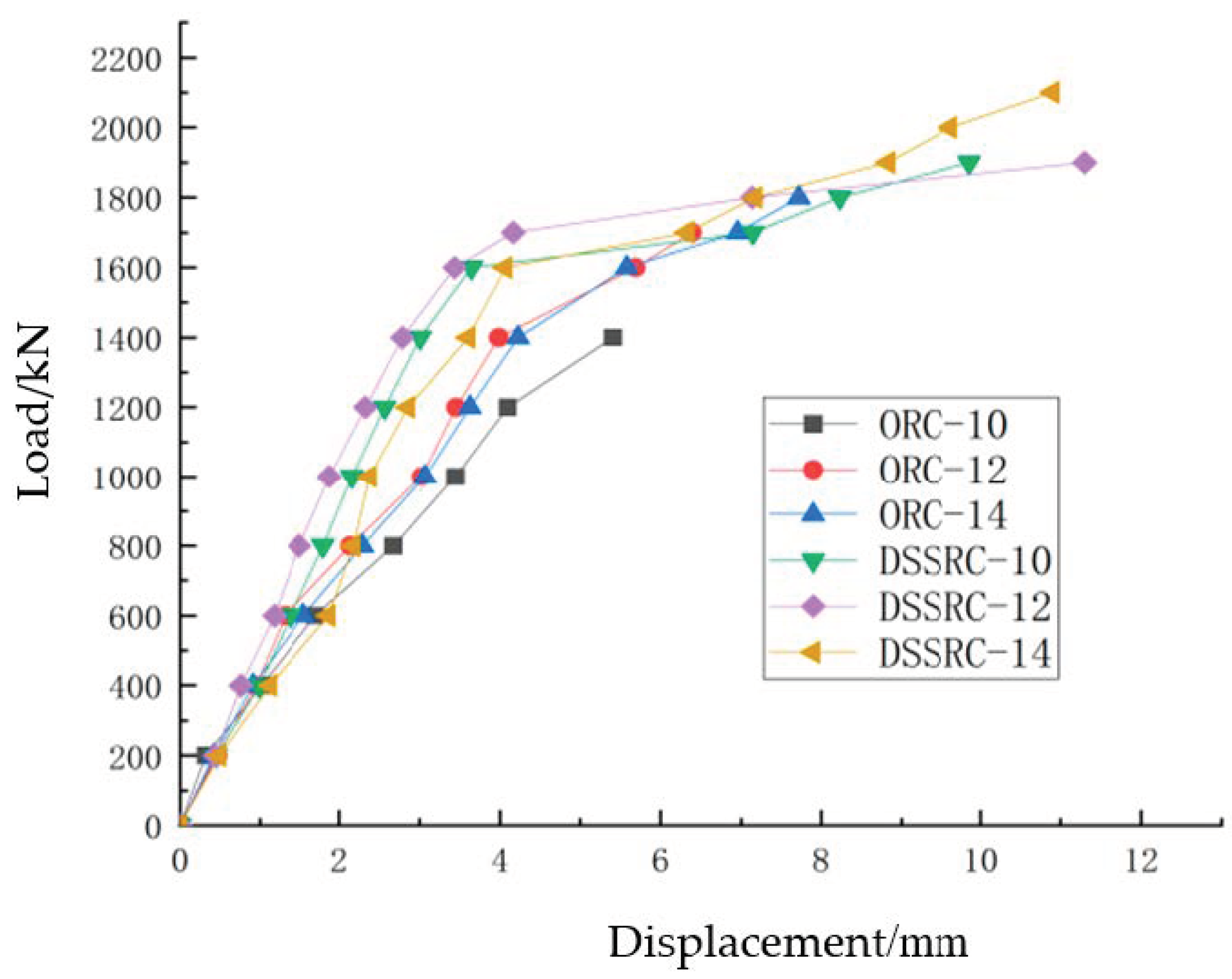
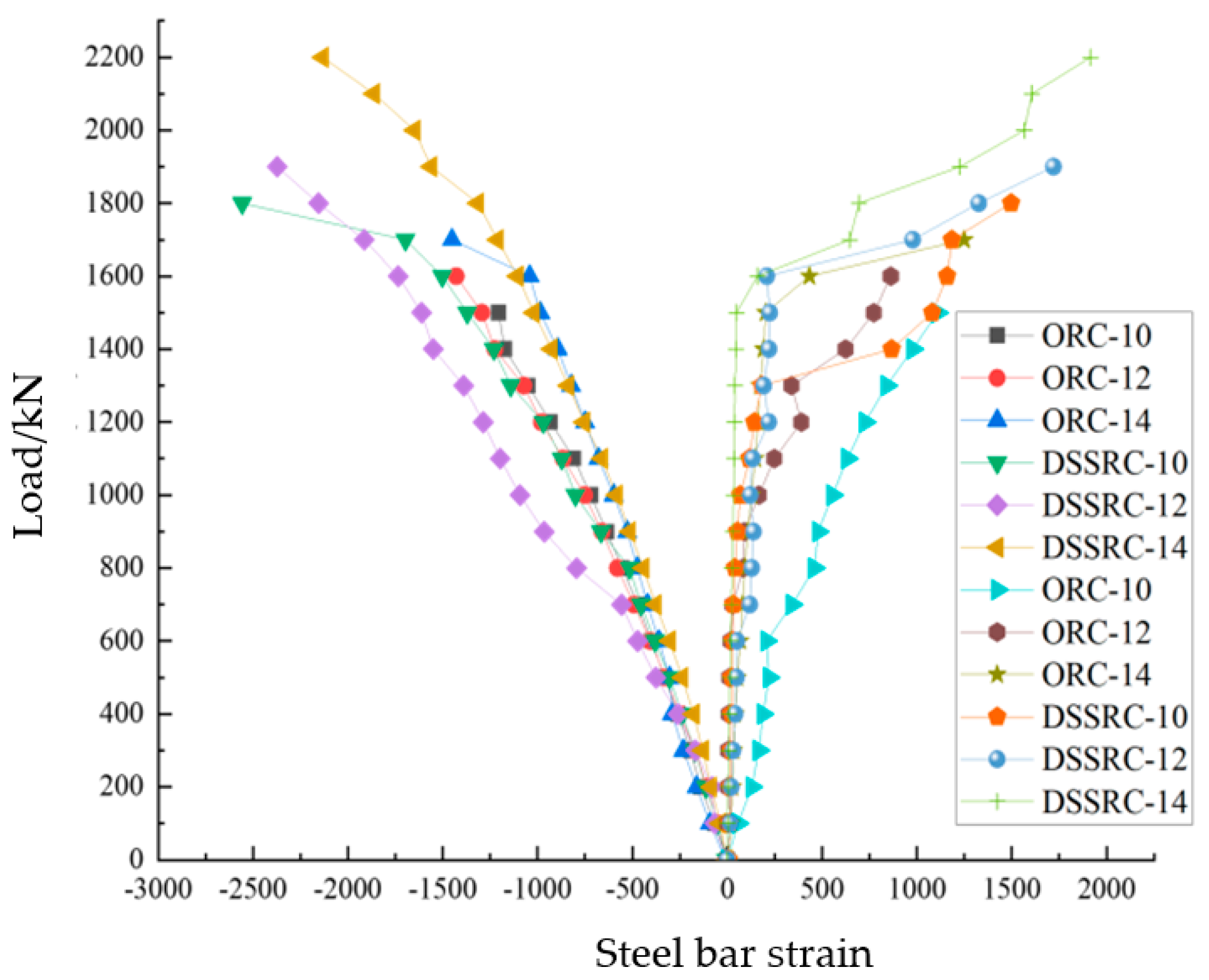


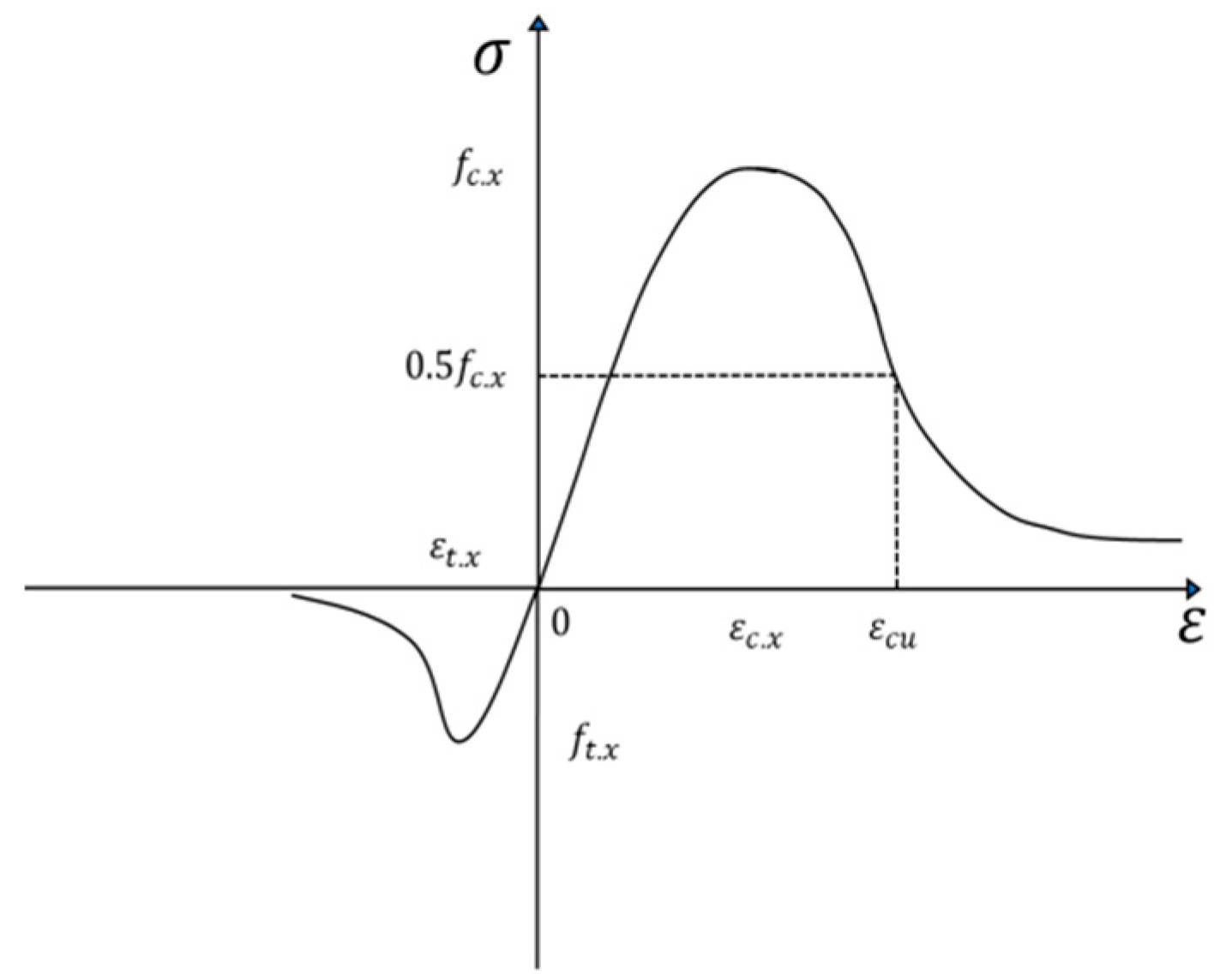
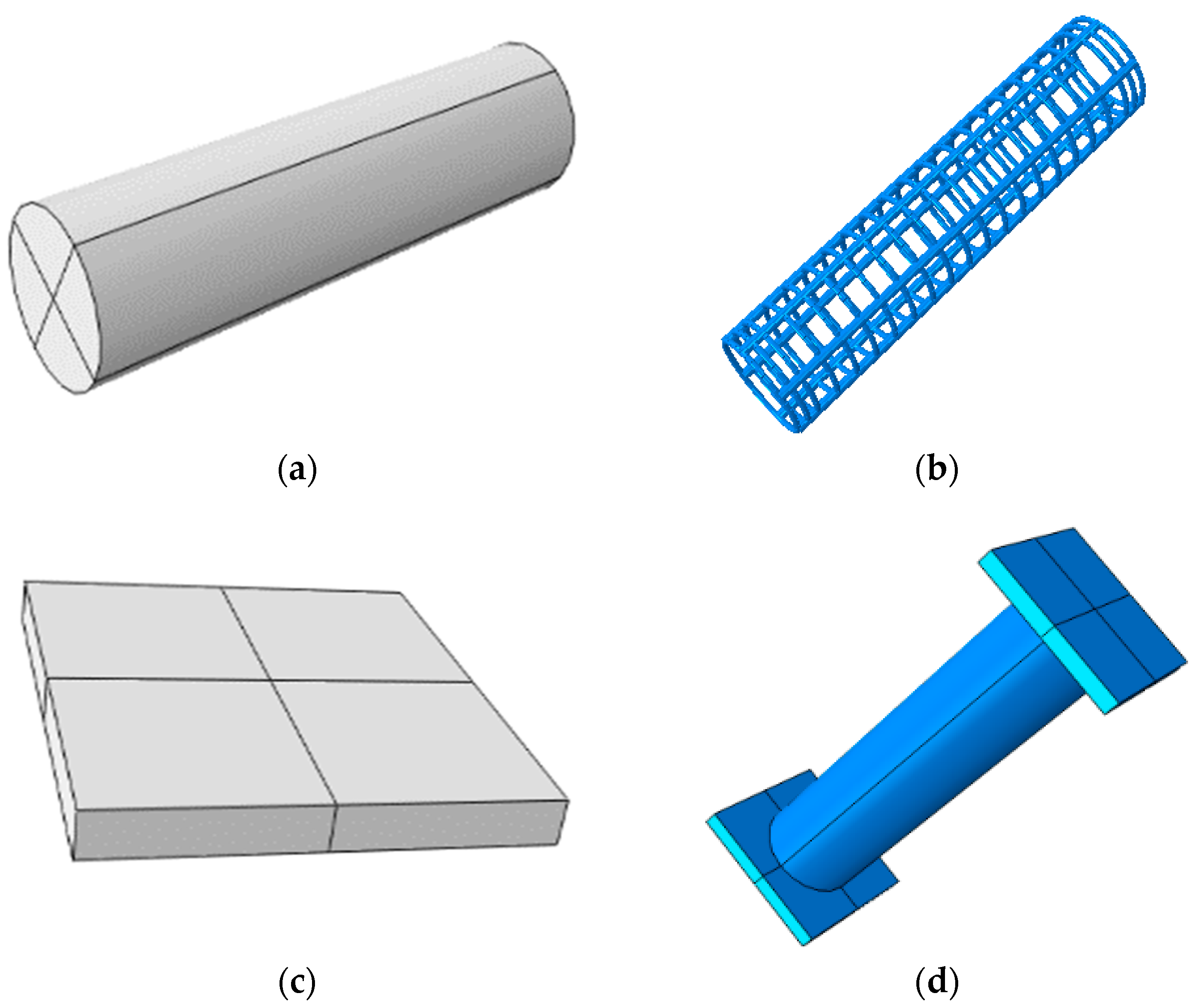
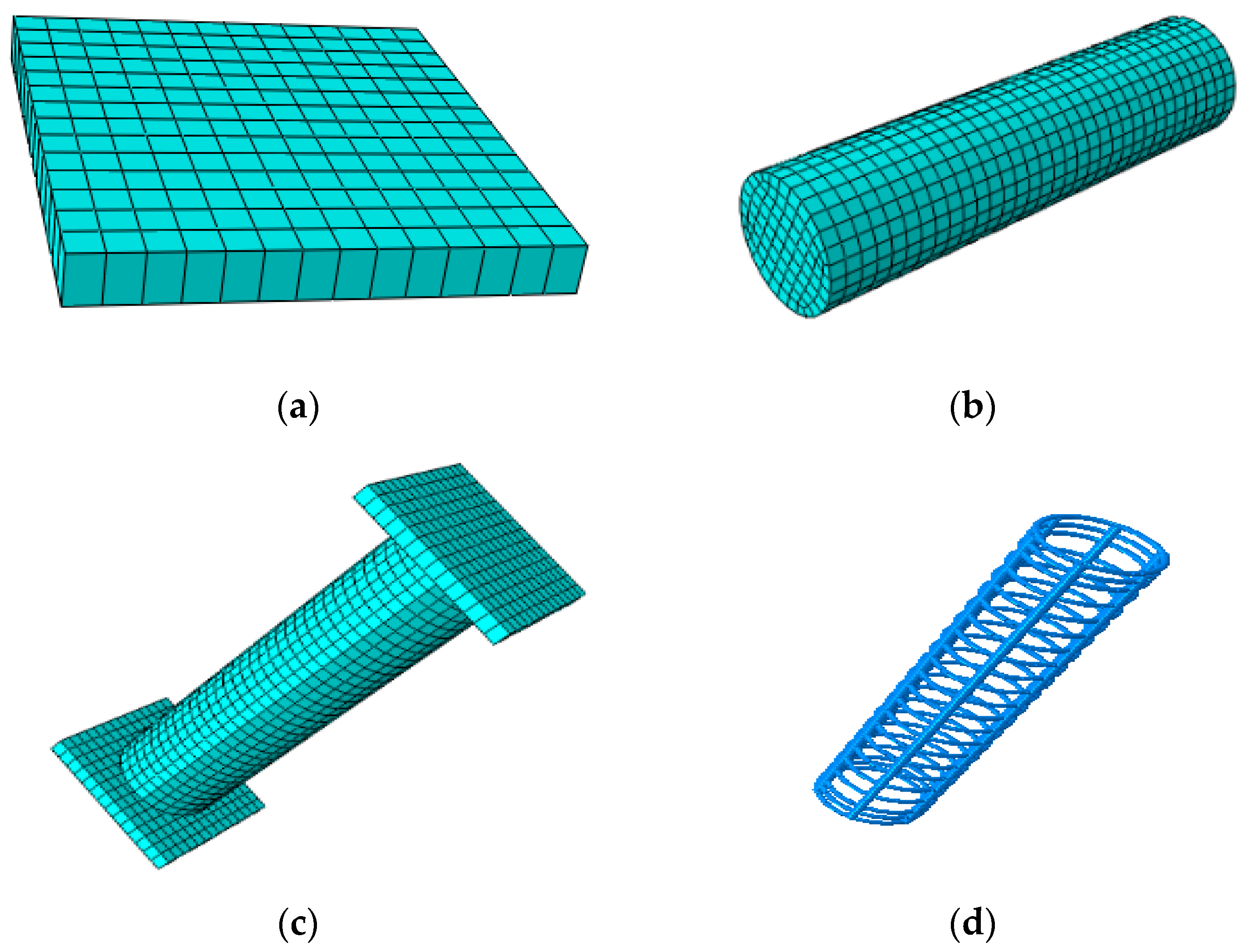


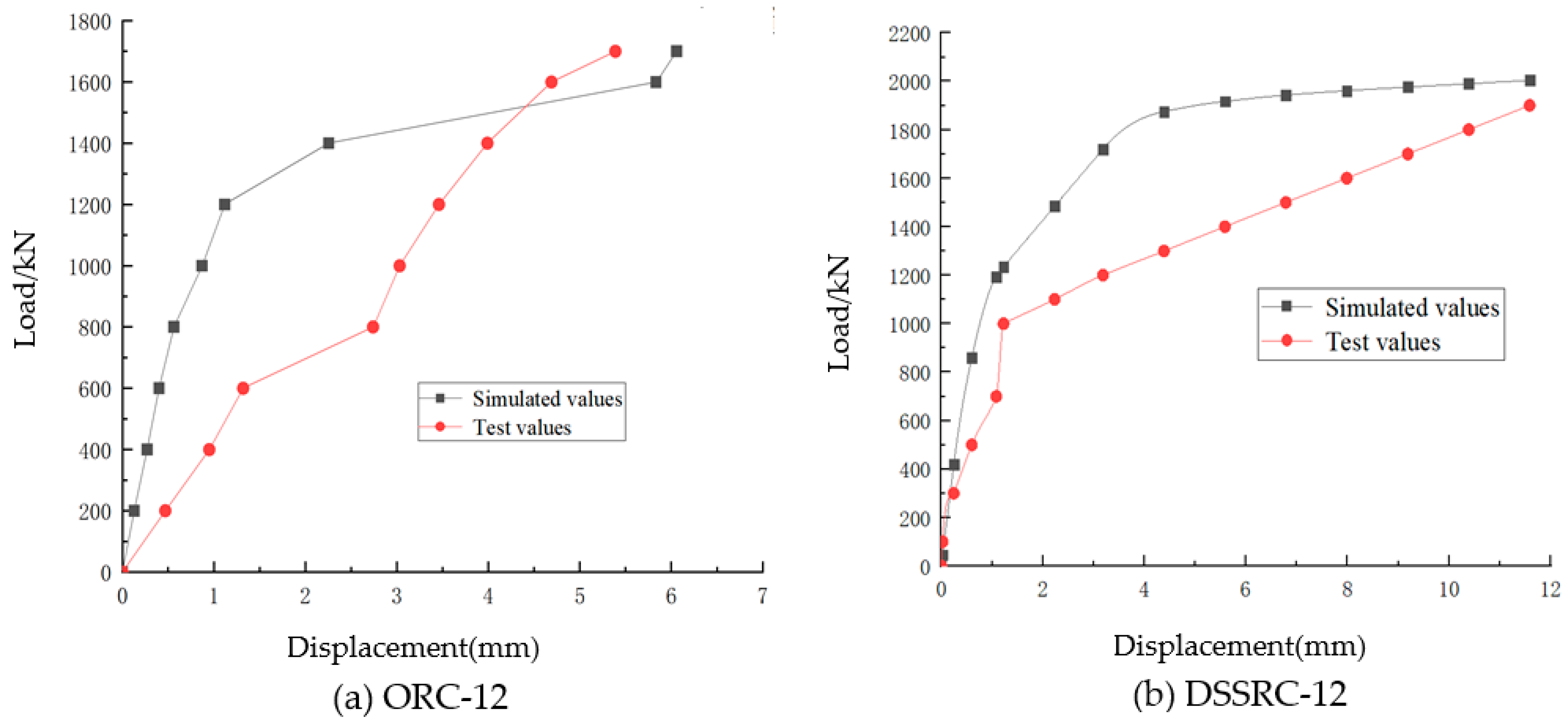
| Batch No. | Test Block No. | Compressive Strength (MPa) | Mean (MPa) |
|---|---|---|---|
| 1 | Test block 1 | 37.67 | 34.4 |
| Test block 2 | 34.49 | ||
| Test block 3 | 31.04 | ||
| 2 | Test block 4 | 30.67 | 30.26 |
| Test block 5 | 30.39 | ||
| Test block 6 | 29.73 |
| Material | Diameter | Yield Strength (MPa) | Ultimate Strength (MPa) | Elasticity Modulus (GPa) |
|---|---|---|---|---|
| HRB400 | 6 | 360.4 | 424 | 201 |
| 10 | 339.2 | 399.1 | 201 | |
| 12 | 359.2 | 438.9 | 200 | |
| 14 | 395.1 | 465.5 | 202 | |
| S2205 | 6 | 552.8 | 650.4 | 164 |
| 10 | 609.1 | 716.5 | 162 | |
| i | 12 | 683.1 | 803.6 | 165 |
| 14 | 563.9 | 583.9 | 164 |
| Specimen No. | Stirrup Diameter | Stirrup Spacing | Number of Rebars | Rebar Diameter | Reinforcement Ratio | Number of Specimens |
|---|---|---|---|---|---|---|
| ORC-10 | 6 mm | 50 mm | 6 | 10 mm | 0.9% | 3 |
| ORC-12 | 6 mm | 50 mm | 6 | 12 mm | 1.3% | 3 |
| ORC-14 | 6 mm | 50 mm | 6 | 14 mm | 1.7% | 3 |
| DSSRC-10 | 6 mm | 50 mm | 6 | 10 mm | 0.9% | 3 |
| DSSRC-12 | 6 mm | 50 mm | 6 | 12 mm | 1.3% | 3 |
| DSSRC-14 | 6 mm | 50 mm | 6 | 14 mm | 1.7% | 3 |
| Specimen No. | Cracking Load | Mean | Ultimate Load | Mean | Growth Rate % | Δ (mm) | εs (10−6) |
|---|---|---|---|---|---|---|---|
| ORC-10 | 665 | 677 | 1543.2 | 1430 | — | 5.41 | −1206.5 |
| 681 | 1318.4 | ||||||
| 686 | 1409.3 | ||||||
| DSSRC-10 | 800 | 817 | 2001.3 | 1870 | 30.7% | 9.86 | −2557.5 |
| 750 | 1742.3 | ||||||
| 950 | 1868.4 | ||||||
| ORC-12 | 700 | 700 | 1730.0 | 1646 | — | 6.39 | −1428.2 |
| 740 | 1680.5 | ||||||
| 660 | 1527.8 | ||||||
| DSSRC-12 | 876 | 789 | 2099.4 | 1996 | 17.5% | 11.30 | −2373.1 |
| 791 | 1976.5 | ||||||
| 700 | 1913.0 | ||||||
| ORC-14 | 540 | 670 | 1690.0 | 1730 | — | 7.72 | −1450.9 |
| 672 | 1651.4 | ||||||
| 800 | 1849.0 | ||||||
| DSSRC-14 | 700 | 1000 | 2031.2 | 2213 | 27.9% | 10.90 | −2133.2 |
| 1200 | 2155.6 | ||||||
| 1100 | 2455.1 |
| Specimen No. | Experimental Average/kN | Theoretical Average/kN | Experimental Value/Theoretical Value |
|---|---|---|---|
| ORC-10 | 1430.8 | 1349.81 | 1.06 |
| DSSRC-10 | 1870.67 | 1635.64 | 1.14 |
| ORC-12 | 1646.27 | 1450.62 | 1.13 |
| DSSRC-12 | 1996.3 | 1822.41 | 1.09 |
| ORC-14 | 1730.13 | 1569.49 | 1.10 |
| DSSRC-14 | 2213.97 | 1817.07 | 1.21 |
| Eccentricity | Viscosity Parameter | |||
|---|---|---|---|---|
| 30 | 0.1 | 1.16 | 0.6667 | 0.0005 |
| Specimen No. | Experimental Value (kN) | Theoretical Value (kN) | Simulated Value (kN) | Experimental Value/Theoretical Value | Experimental Value/Simulated Value |
|---|---|---|---|---|---|
| ORC-10 | 1430.80 | 1349.81 | 1427.7 | 1.06 | 1.00 |
| DSSRC-10 | 1870.67 | 1635.64 | 1788.5 | 1.14 | 1.04 |
| ORC-12 | 1646.27 | 1450.62 | 1511.2 | 1.13 | 1.08 |
| DSSRC-12 | 1996.30 | 1822.41 | 1974.2 | 1.09 | 1.01 |
| ORC-14 | 1730.13 | 1569.49 | 1612.8 | 1.10 | 1.07 |
| DSSRC-14 | 2213.97 | 1817.07 | 2031.7 | 1.21 | 1.09 |
Disclaimer/Publisher’s Note: The statements, opinions and data contained in all publications are solely those of the individual author(s) and contributor(s) and not of MDPI and/or the editor(s). MDPI and/or the editor(s) disclaim responsibility for any injury to people or property resulting from any ideas, methods, instructions or products referred to in the content. |
© 2023 by the authors. Licensee MDPI, Basel, Switzerland. This article is an open access article distributed under the terms and conditions of the Creative Commons Attribution (CC BY) license (https://creativecommons.org/licenses/by/4.0/).
Share and Cite
Ren, Z.; Wang, H.; Fang, L.; Ding, P.; Zeng, X. Test and Numerical Simulation of the Axial Compressive Capacity of Concrete Columns Reinforced by Duplex Stainless Steel Bars. Buildings 2023, 13, 2845. https://doi.org/10.3390/buildings13112845
Ren Z, Wang H, Fang L, Ding P, Zeng X. Test and Numerical Simulation of the Axial Compressive Capacity of Concrete Columns Reinforced by Duplex Stainless Steel Bars. Buildings. 2023; 13(11):2845. https://doi.org/10.3390/buildings13112845
Chicago/Turabian StyleRen, Zhenhua, Hui Wang, Lizheng Fang, Peng Ding, and Xiantao Zeng. 2023. "Test and Numerical Simulation of the Axial Compressive Capacity of Concrete Columns Reinforced by Duplex Stainless Steel Bars" Buildings 13, no. 11: 2845. https://doi.org/10.3390/buildings13112845
APA StyleRen, Z., Wang, H., Fang, L., Ding, P., & Zeng, X. (2023). Test and Numerical Simulation of the Axial Compressive Capacity of Concrete Columns Reinforced by Duplex Stainless Steel Bars. Buildings, 13(11), 2845. https://doi.org/10.3390/buildings13112845







